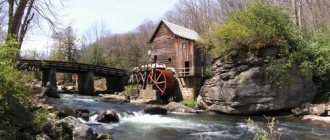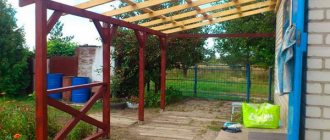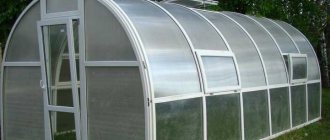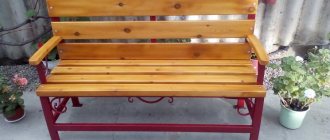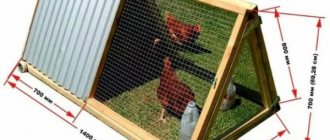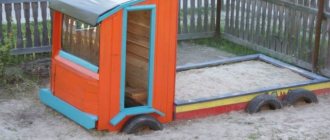Receiving water flow
If it is not possible to ensure natural water flow, they resort to an artificial method. Here are the options:
- Decorative structures are placed under the gutter, and then the wheel rotates when it rains. Although a small pump and a watering hose, through which water is supplied to the roof, will allow you to start the mechanism even in the absence of precipitation. The water that flows onto the wheel can then be discharged into the garden.
- To organize the flow, uneven terrain of the site is used. On a hill, a container is dug into the ground in which precipitation accumulates or water flows from a well. A mill is placed near the container, to which the liquid is supplied through a chute.
- On a flat area, a hill is created, if desired, artificially, using the “alpine hill” technology - using compacted soil and cobblestones. You can wall up a hose in the middle of the architectural form; the water gushing out of it will simulate an underground spring.
- The pump power must be sufficient to pump water from the reservoir below to the storage tank at the top or supply it to the mill wheel itself. The power depends on the distance over which the liquid is supplied.
Ways to create a water flow
You can ensure a constant supply of water to the mill wheel using the following solutions:
- drain;
- unevenness of the site;
- pump installation.
In the first case, the device is located under the gutter from the drain, so the mill will only work if it is raining outside. But to create a falling flow of water, some summer residents adapt the unevenness of the site, for example, a natural alpine slide.
At a short distance from the mill, a collection point is created for the liquid, which will be fed through a chute to the wheel. But you can make the unevenness with your own hands from available materials - stones, bricks and compacted earth; a hose is installed inside the structure, which supplies water. Installing a pump in a reservoir involves the supply of liquid under pressure to the wheel , thereby ensuring its constant movement. This could be a shallow pond, a well or a tank.
Also read: Topiary in landscape design
At a short distance from the mill, a collection point is created for liquid, which will be fed to the wheel through a chute.
Homemade mill
The construction of the main structure begins after the completion of the water level difference. The design of the mill is quite simple: you need a house with a pump and a wheel driven by the force of water passing into the lower reservoir from the upper.
If there is a cascade, you can do it without a house - one or several wheels will be enough. The structure can be made of wood, brick, or other suitable material.
The wheel can be made like this:
- From a bicycle wheel.
- Using a cable reel.
- From a circle cut from knocked together boards.
- From a piece of pipe with blades attached to them .
In any case it should be the following:
- Blades.
- In the center of the wheel there is a pipe for mounting the axle around which rotation occurs.
- The parts are attached mechanically.
Two supports are made, onto which the axle is movably attached using bearings. The chute is brought to the top of the wheel. If the blades are made of wood, it is worth opening them with varnish that repels water. It is recommended to paint metal blades to protect them from rust. Channels are being built through which water will flow to the garden or other place.
The supports can be made of rubble or brick: the edges that deteriorate over time will only add originality to the structure. Stone and brick are combined with wood.
The service life of wooden elements will be longer if they are made of hardwood. Metal parts are treated with phosphoric acid: in this case, corrosion will remain superficial, and natural aging will add originality to the look.
Decoration can be done using the following materials:
- bamboo;
- straw;
- ceramic tiles.
The place where the stream of water hits can be covered with sea pebbles. Ornamental plants are planted on the sides of the gutter and near the house. The area around the structure can be paved with tiles.
Making a water mill yourself
A water mill mounted on a garden plot must correspond to its size. Agree that on the traditional six hundred square meters, an epic structure made of logs will look funny. But a working miniature will come in handy. A medium-sized mill house can be used to store equipment or children's toys.
Just like the real thing, only small
To begin with, you can build a model of a mill. For this you will need:
- paving slabs size 75x50 cm;
- paving stones, which look like cubes in the picture;
- wooden slats;
- bitumen shingles;
- plywood;
- threaded brass rod;
- bushings;
- screws and dowels;
- glue for woodworking;
- protective impregnation.
All dimensions of the structure are shown in the figure below.

All dimensions of this model are given in centimeters; by carefully examining the diagram and reading the instructions for creating the model, you will not be mistaken when performing the work
We attach cube stones in the shape of the number “9” along the edge of the paving slabs. We cover them on top with a solution, which we level with a damp sponge. Use a jigsaw to cut the slats to size. From these we assemble the frame of the structure. To make this connection, we glue the racks together, and secure the corner parts with a “half-wood” notch.

In order for the result of the work to cause satisfaction, it is necessary to complete it without haste and consistently, moving from one stage to another.
We attach the resulting frame to the base through the struts with dowels and screws. We fill the frame with tiles. To do this, we cut it to size with a circular saw and glue it with silicone. We apply the image of the wheel rims to a sheet of plywood, and then carefully cut out the parts with a jigsaw.
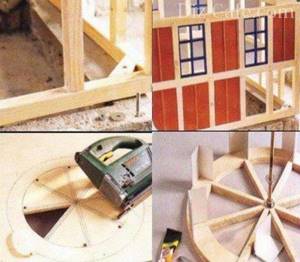
All wooden parts of the structure should be thoroughly impregnated with an antiseptic solution: the structure will be located outdoors in snow and rain
An overview of means to protect wood from moisture, fire, insects and rot will also be useful:
We glue pieces of aluminum corner to one half of the wheel at distances that correspond to the intervals between the spokes. The corners imitate wheel blades. We make a support for the wheel, gluing it and connecting it with screws to be sure. A glued piece of aluminum pipe will strengthen the hole for the axle.
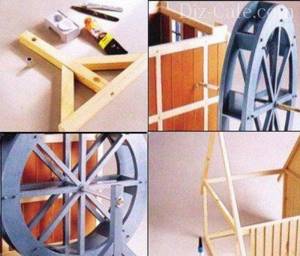
The wheel is the working part of the mill, the quality of which should be given special attention, because the overall life expectancy of the structure depends on its service life
A brass rod is used as an axis. A spacer sleeve and an aluminum tube are placed on it as reinforcement for the wall. Another spacer is needed to provide clearance between the support and the wheel. A nut is screwed onto the thread of the brass rod.
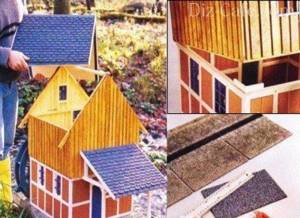
The finished mill looks great and is pleasing to the eye; check again how securely all its elements are fastened, and you can start testing on the water
The upper part of the structure frame is sheathed with slats. Wooden corners that are glued to the corners of the lower part allow the individual structural elements to be correctly aligned. The tiles are cut with a wallpaper knife and glued with bitumen glue. The structure is ready.
Styling
A DIY water mill will fit perfectly into a country-style landscape design. The size of the structure is selected depending on the power of the water flow, although approximately 1 m of height is enough for decoration.
The unique “half-timbered” style, when the frame of the building is visible from the outside, is also popular . To decorate a plot in this style, a summer resident will need brown and white paint, thin slats and roof tiles. The mill house is painted white, then covered with decorative stripes. The surface is divided into triangles and small squares. As a result, the front part will take on a very unusual appearance. Near the mill you can plant white flowers or place a brown bench.
Many people prefer Japanese style. If it is chosen, the main decorations of the mill will be stones, plants and the water itself. The color of the house should be dark. If desired, a stone tower or bench is built, and dwarf trees are planted around. The wheel is decorated with sand, pieces of shells or pebbles.
Whatever style your country area is decorated in, a water mill that harmoniously fits into the overall style will decorate your summer cottage!
Making a mill for the garden with your own hands
First of all, you need to draw a sketch of the future device or find it on the Internet. You can use various objects as a base, for example, wheels from a bicycle, car or toys. But you can make a mill wheel with your own hands using the following materials:
- solid wood or moisture-resistant plywood;
- metal tube;
- nuts and screws.

Half-timbering is a unique style in which the frame of the building is visible from the outside
To create the base and other parts you will need tools such as an electric jigsaw, circular saw, hammer, screwdriver.
To begin with, you need to create 2 wooden disks of equal diameter, between which blades are attached, which can be made from plywood, attach them at equal intervals. In the center of the wheel you need to install a piece of metal tube for the axle, with the help of which it will be attached on one side to the mill body, on the other - to the support, it is assembled from wooden blocks. They should be installed firmly enough using fasteners.
Also read: Do-it-yourself polycarbonate greenhouse: installation and construction technology step by step
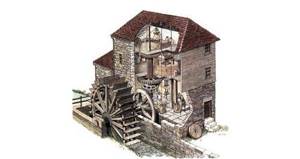
You need to draw a sketch of the future device or find it on the Internet
When the wheel is ready, you can proceed directly to the manufacture of the water mill.
- On the 1st floor you need to create a small house or building according to the diagram, which should be prepared in advance. You can make a small building from wood or other available materials, depending on the final style decision chosen by the gardener. The easiest way is to create a wooden frame, for this purpose you will need 4 equal pieces of waterproof plywood and straw as a roof, or you can make a roof from miniature tiles or stones. All wooden elements of the future body must be sanded using an electric jigsaw and fastened together, paying special attention to the side cuts.
- The 2nd stage of manufacturing a water mill is characterized by the impregnation of wooden parts with special compounds that protect the device from moisture, insects and mold. It is best to process all the elements in several layers, since the mill will be in constant contact with water. All parts of the device must be completely dry.
- On the 3rd floor , all manufactured parts of the mill must be assembled into a single structure. The fastening mechanism should be combined with the house by drilling a hole in one of the walls and inserting an axle there. The structure is secured with a nut attached to the end of a metal tube. In a tank of water, the device begins to work and the wheel is constantly in motion.
We ensure style matching
The best addition to the country style can be a water mill. Photos of some successful design solutions are presented in the article.

The size of the mill is selected depending on the power of the flow of a river or stream, but for the decorative design of the site, a structure about a meter high will be sufficient. The mill supports can be made of rubble. Brick may be a good option for their construction: the edges that break off over time will make the structure more original. Stone and brick work well with wood, but in order for wooden parts to last longer, they should be made from hardwood. Metal parts must be treated with phosphoric acid: in this case, the corrosion will remain superficial and will give the structure originality due to natural aging.
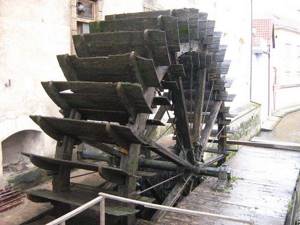
To decorate a mill house, you can use straw, bamboo, and ceramic tiles. You can sprinkle sea pebbles under a stream of falling water. Ornamental plants are planted along the edges of the water trough and near the house. A water mill will decorate your summer cottage.
In conclusion, a video about creating a landscape using a water mill.
